Have you started reading a health journal about the glycemic index, glycemic load, glucose spikes, etc. only to get confused and unsure on which information to pay attention to? One of our boot camp members asked me about the glycemic index last week.. so here is our very first QnA post!
Glycemic Index– a way of measuring impact of foods on blood sugar levels. If the GI is high, carbohydrates are converted quickly into sugar and cause blood sugar levels to spike.
The numbers: 70+ GI = high, 59-69 GI = medium, less than 55 GI = low.
The glycemic index compares foods containing the same amount of a carbohydrate to raise the blood glucose level. However, the amount of carbohydrates you consume is what impacts your health. Eating more of a food does not impact the GI. This is where glycemic load (GL) comes into play.
Glycemic Index = quality, Glycemic Load = quantity
What is Glycemic Load?
Glycemic Load – measure the impact of a carbohydrate on the system. Glycemic load is derived from a simple math equation.
Glycemic Load = (Glycemic Index x # carbohydrates (in grams)) ÷ 100
The numbers: 120+ GL = high, 11-19 GL = medium, less than 10 GL = low.
For example: watermelon has a high GI, but since you eat a relatively low number of carbohydrates, it has a low GL.
*Foods that have a low GL almost always have a low GI. Foods with a mid to high GL range from very low to very high GI.*
The numbers: a daily glycemic load of 80 or less is low. A daily glycemic load of 120+ is high.
What are the benefits of eating foods with a low glycemic index?
- Lose and manage weight
- Improves diabetes management
- Reduces risk of heart disease
- Improves blood cholesterol levels
- Reduces hunger and keeps you full longer
- Prolongs physical endurance (you’ll give 110% during boot camp!)
- Refuel carbohydrate stores after exercise
- Boosts energy level
Quick tips
1. The ripening process affects a foods glycemic index. A ripe food will have a higher GI because it has higher sugar content.
2. Processed food will also have a higher GI. For example, a glass of orange juice will have a higher GI than a whole orange.
3. Cooking food will increase the GI. Cooking speeds up the digestion of food so once consumed it will cause a higher spike in blood sugar.
4. Eat more fruits and vegetables in your diet and less bread and processed food.
I hope you enjoyed this post! Our next QnA post will be about different milk options: dairy milk, almond milk, coconut milk, etc. and which one to choose. Please email me your question at laura@laurafortefitness.com.
Committed to your health and fitness success,
Laura
[fblike url=”http://www.laurafortefitness.com/2011/12/1108/” style=”standard” showfaces=”false” width=”450″ verb=”like” font=”arial”]

